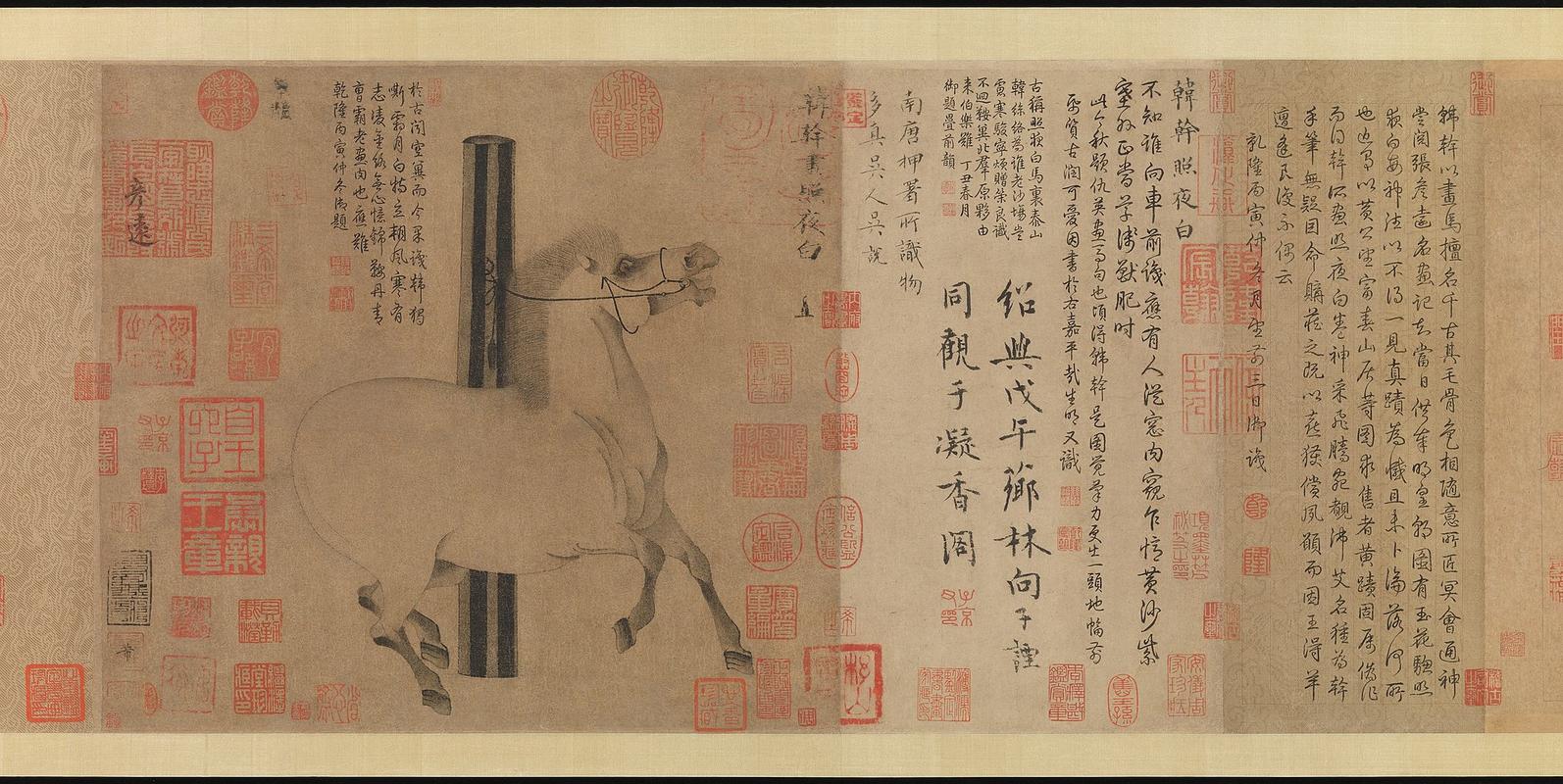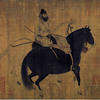More about Night-Shining White

Contributor
Han Gan was the leading horse painter of his time in Tang Dynasty China.
Night-Shining White, his most famous work, was a piece commissioned to him by Emperor Xuanzong, regent at the time and a very devoted patron of the arts. The painting is an example of “baihua,” or “white painting,” a term used for monochromatic ink drawings and has a provenance that spans nearly a thousand years, judging by the amount of stamps on the painting. The depiction of the horse is meant to evoke myths of Central Asian horse breeds as dragon-steeds, firey and powerful.
Born Li Longji, Emperor Xuanzong was the third son of the Ruizong Emperor. Longji was named heir apparent after playing a vital role in bringing his father back to power in 710, five years after the Empress Wuhou, who deposed him, passed away. Two years later, his father abdicated and the man that would become Xuanzong took the throne, assuming most of his responsibilities while his father sat back in a more cushy position as “Supreme Emperor,” a fancy title for what amounted to being like a board of directors appointing people for high positions. Thank Xuanzong’s sister Taiping for that. In 713, fate blew its winds and Taiping got knocked off her rocker, losing a power struggle between herself and Xuanzong. She committed suicide, while he took full control of the state.
Xuanzong, unbothered as all could be, went right to work. He reformed and streamlined the bureaucracy, bloated as all hell, by outlawing purchase of office and restoring both authority of the emperor and efficiency of government in one fell swoop. He restored the canal system that fell into disrepair under the Wuhou empress and led successful military campaigns against the Tibetans, the Turks, and the Khitans. He managed to maintain a balance of power between the families of consorts, the imperial clan, palace officials, and the magistrates, bringing evidence that his mandate under heaven was justified. All was good, until a point.
Starting in 721, storms would start to form in the horizon as the elegance and efficiency of the reformed system became a liability for Xuanzong’s authority. Government reforms streamlined tax collection, renewing the ledgers and bringing more power to the aristocracy through greater revenues. Successful campaigns were made possible by a larger standing army, which meant more generals were needed to oversee them. The convenience of the canal system meant that Xuanzong didn’t need to move the capital anymore.
In 737, Li Linfu, the chief representative of the aristocracy, had the most power in the state. Chief ministers and financial overseers became increasingly corrupt. Military governors in the far corners of the empire, such as An Lushan, exerted territorial authority as much as they exerted military presence. All the while, Xuanzong himself became withdrawn in his Taoist studies, all the while having to deal with two power-hungry consorts, one of whom was responsible for Linfu’s rise to power. At some point, he fled with a small contingent to the Sichuan province, where he stayed for the rest of his days, abdicating his throne to his heir apparent and, miraculously for regents stuck in power struggles, living in retirement until his death in 762. The dragon-steed, like its owner, reflects Xuanzong’s temperamental, yet majestic reign.
Sources
- Britannica, The Editors of Encyclopaedia. “Xuanzong.” Encyclopædia Britannica. Encyclopædia Britannica, inc. Accessed September 11, 2019. https://www.britannica.com/biography/Xuanzong.
- Hearn, Maxwell K. How to Read Chinese Paintings. New York: Metropolitan Museum of Art, 2008.
Featured Content
Here is what Wikipedia says about Night-Shining White
"Night-Shining White" (Chinese: 照夜白圖) is a monochrome ink-on-paper painting by the Chinese artist Han Gan. It is an example of Tang dynasty painting, created in the middle of the 8th century (circa 750). The work depicts a cavalry horse owned by the Emperor Xuanzong (reign 712–56) of the Tang dynasty, tethered to a post. It is considered one of the greatest equine portraits in Chinese painting. It was acquired by the Metropolitan Museum in 1977.

In his time, Han Gan was considered one of the leading artists of China. Originally from a poor family, Han Gan was working in a wine shop in the capital Chang'an when his artistic talent was spotted by the painter and poet Wang Wei, and he became an artist at the imperial court. He was famous for being able capture the character of a horse as well as its physical appearance. European art historians often note the conventionality of the drawings of Han Gan and other representatives of Chinese painting and see this as a significant difference in Chinese animalistics from works depicting animals created by European artists.
By order of Emperor Xuanzong, Han Gan created a series of "portraits" of famous horses, and this work may originally have been just one of a series of paintings. Many of the original paintings have not survived, but they are known through copies made in subsequent centuries.
The work is an example of bai hua or "white painting", a monochrome work created using a brush and black ink, with economy of line and some simple shading but no colours. The composition is based on earlier works of Chinese art, but despite its limited materials, "Night-Shining White" does not lose its spirituality and restless energy. The painting shows Han Gan's close observation of the subject: in conversation with the Emperor, Han Gan claimed that the horses in the stables were his teachers of painting.
The animals depicted in traditional Chinese painting are usually not as anatomically precise as those found in Western paintings, and "Night-Shining White" is not an entirely realistic portrait. The horse is depicted with characteristic features of the fiery-tempered horse of Chinese mythology, indicative of a dragon in disguise as a celestial steed: large burning eyes, flaring nostrils and dancing hoofs. It proportions are somewhat exaggerated, with short and very thin legs and a very round body. Han Gan gave the horse some human features, with eyes are turned to the viewer that seem to appeal to compassion and help.
The work was later interpreted as an emblem of Chinese military strength and imperial power, but with undertones of peril: Emperor Xuanzong was distracted by his infatuation with a concubine, neglected his duties, and was deposed.
The work is not signed by the artist, but it bear numerous inscriptions, seals and signatures from its subsequent owners—including the seals of the Southern Tang emperor Li Yu, the Song theorist Mi Fu, and the Qianlong Emperor—show that it passed through the hands of many collectors over the following 1,200 years. The original drawing some 12 inches (30 cm) square was later mounted on a 20 feet (6.1 m) long handscroll to provide sufficient space for the seals and inscriptions.
It later came into the collection of Sir Percival David, and was bought by the Metropolitan Museum in 1977, funded by the Dillon Fund.
Check out the full Wikipedia article about Night-Shining White













Ancient paintings are one of the most beautiful and significant, not only because they are beautiful to admire but because they convey knowledge and a broad cultural trajectory. This painting designed by bestessay review is one of the most beautiful I have seen.